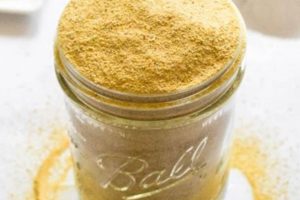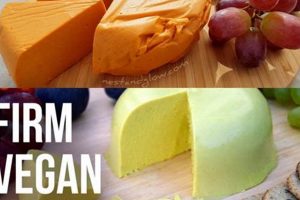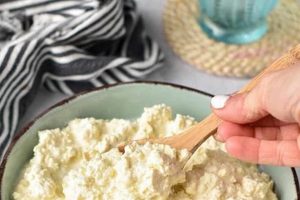A plant-based variation of a classic comfort food, this dish incorporates cauliflower as a key ingredient, often pureed or riced to contribute creaminess and bulk to the sauce. It avoids all animal products, relying instead on plant-derived alternatives like nutritional yeast, cashews, or vegetable-based milk to achieve a cheesy flavor and creamy texture. The dish consists of pasta, typically elbow macaroni, coated in a sauce composed primarily of cauliflower and other vegan ingredients. This creates an alternative to traditional macaroni and cheese suitable for individuals following a vegan dietary pattern.
This innovative adaptation offers several advantages. It provides a lower-fat and cholesterol-free alternative to traditional dairy-based macaroni and cheese, potentially benefiting cardiovascular health. The addition of cauliflower increases the dish’s nutritional value by adding vitamins, minerals, and fiber. The history of adapting classic recipes to plant-based versions reflects a growing awareness of dietary choices and their impact on health and the environment. It caters to individuals seeking both familiar comfort foods and adherence to ethical or dietary principles.
The following sections will delve into specific methods for preparing the dish, exploring various ingredient options and techniques for achieving optimal flavor and texture. The composition of the sauce, the selection of pasta, and complementary seasonings will be addressed in detail, providing a comprehensive guide to creating a satisfying and nutritious plant-based meal.
Tips for Superior Vegan Mac and Cheese with Cauliflower
Achieving optimal flavor and texture in vegan mac and cheese with cauliflower requires attention to detail in both ingredient selection and preparation techniques. These tips provide guidance for creating a consistently satisfying result.
Tip 1: Prioritize Cauliflower Quality: Select fresh, firm cauliflower heads, free from blemishes or discoloration. This directly impacts the final flavor and texture of the sauce, contributing to a smoother, less bitter profile.
Tip 2: Roast the Cauliflower: Roasting the cauliflower prior to blending deepens its flavor and adds a subtle sweetness, reducing the raw, vegetal taste that can sometimes be present. Toss florets with olive oil, salt, and pepper before roasting at 400F (200C) until tender and lightly browned.
Tip 3: Utilize High-Quality Nutritional Yeast: The quality of nutritional yeast significantly impacts the cheesy flavor. Opt for brands known for their savory, umami notes, avoiding those that taste bitter or metallic. Start with a smaller amount and adjust to taste.
Tip 4: Employ Cashews for Creaminess: Soaked cashews, when blended, provide a rich and creamy base. Soak raw cashews in hot water for at least 30 minutes, or preferably longer, to soften them sufficiently for a smooth sauce. Ensure thorough blending to eliminate any grainy texture.
Tip 5: Balance Flavors with Acid: A touch of acidity, such as lemon juice or apple cider vinegar, balances the richness of the sauce and enhances the overall flavor profile. Add a small amount and adjust to taste, ensuring it complements rather than overpowers the other ingredients.
Tip 6: Adjust Liquid Consistency: The amount of liquid used affects the sauce’s thickness. Start with less liquid and gradually add more until the desired consistency is achieved. Vegetable broth or plant-based milk can be used to adjust the texture without compromising the vegan character of the dish.
Tip 7: Season Generously: Don’t be afraid to experiment with seasonings. Garlic powder, onion powder, smoked paprika, and mustard powder can all contribute to a more complex and satisfying flavor. Taste and adjust throughout the cooking process.
Employing these techniques will elevate the final outcome, resulting in a more flavorful, texturally appealing, and nutritionally enhanced rendition of the described dish. Attention to detail during each stage of preparation is key to achieving a premium plant-based culinary experience.
Consider these tips when preparing the recipe detailed in the subsequent sections to achieve optimal results.
1. Flavor
Flavor is a primary determinant of the overall success and palatability of vegan mac and cheese with cauliflower. The absence of traditional dairy cheese necessitates a strategic approach to achieving a satisfying and recognizable cheesy flavor profile. Nutritional yeast is a key ingredient, providing umami and savory notes that mimic the characteristics of aged cheese. The quantity and quality of nutritional yeast directly impact the intensity and authenticity of the desired flavor. Additions such as garlic powder, onion powder, and smoked paprika contribute depth and complexity, enhancing the overall sensory experience.
The preparation method of the cauliflower also significantly influences flavor. Roasting the cauliflower caramelizes its natural sugars, resulting in a sweeter, less bitter taste compared to steaming or boiling. This roasted flavor complements the other ingredients and contributes to a more rounded and balanced flavor profile. Furthermore, the judicious use of salt and pepper is crucial for accentuating the existing flavors and preventing the dish from tasting bland. A small amount of acid, such as lemon juice or apple cider vinegar, can brighten the overall flavor and balance the richness of the sauce.
Achieving a desired flavor in vegan mac and cheese with cauliflower requires careful consideration of individual ingredients and their interactions. The selection of high-quality nutritional yeast, the method of cauliflower preparation, and the strategic use of seasonings are essential factors. While replicating the exact flavor of dairy-based mac and cheese remains a challenge, a well-executed approach can yield a plant-based alternative that is both satisfying and flavorful, addressing dietary needs without compromising on taste. Understanding these flavor dynamics is key for successful vegan culinary adaptation.
2. Texture
Texture plays a pivotal role in the overall satisfaction derived from vegan mac and cheese with cauliflower, significantly influencing its perceived quality. The desired texture is typically characterized by a smooth, creamy sauce that evenly coats the pasta, providing a pleasant mouthfeel. However, achieving this texture in a plant-based adaptation presents unique challenges due to the absence of dairy-based ingredients, which naturally contribute to creaminess. Inadequate processing of cauliflower or cashews (if used) can result in a grainy or gritty texture, negatively impacting the eating experience. Overcooking the pasta can lead to a mushy consistency, while undercooking results in a hard, unpleasant bite. A well-executed recipe addresses these potential pitfalls through careful ingredient preparation and precise cooking techniques.
The texture of the sauce is primarily influenced by the preparation method and the ingredients employed. Pureeing the cauliflower thoroughly, ideally after roasting or steaming, is crucial for creating a smooth base. If cashews are incorporated, they must be soaked adequately and blended until completely smooth to avoid any residual graininess. Adjusting the liquid content, typically with plant-based milk or vegetable broth, allows for fine-tuning the sauce’s consistency to achieve the desired level of creaminess. The pasta selection also affects the final texture; certain pasta shapes, such as elbow macaroni or shells, are designed to hold the sauce effectively, enhancing the overall textural experience. For instance, a smoother, more uniform pasta shape may not effectively bind the creamy sauce, resulting in a less desirable mouthfeel compared to a pasta with ridges or curves.
Ultimately, mastering the texture of vegan mac and cheese with cauliflower requires a nuanced understanding of ingredient properties and their interaction. Careful attention to detail during each stage of preparation, from cauliflower processing to pasta cooking, is essential for achieving a satisfying and appealing final product. The textural elements are crucial to the successful adaptation of a comfort food classic into a plant-based format, ensuring it is both palatable and enjoyable, thereby linking directly to the broader goal of offering delicious and appealing vegan alternatives.
3. Nutrition
The nutritional profile of vegan mac and cheese with cauliflower deviates significantly from traditional dairy-based versions, exhibiting both advantages and areas requiring mindful consideration. The absence of dairy inherently eliminates cholesterol and reduces saturated fat content, factors associated with cardiovascular health benefits. Cauliflower contributes vitamins, minerals, and dietary fiber, augmenting the overall nutrient density of the dish. Specifically, cauliflower provides Vitamin C, Vitamin K, and various B vitamins, supporting immune function, blood clotting, and energy metabolism. The fiber content promotes satiety and aids in digestive regularity.
However, replacing dairy cheese with plant-based alternatives necessitates careful attention to macronutrient balance. Many vegan cheese substitutes are higher in sodium and may contain refined oils, impacting their overall healthfulness. The protein content, typically lower than in dairy-based mac and cheese, can be supplemented with additions such as nutritional yeast (a source of B vitamins and protein), legumes, or nuts. Additionally, ensuring adequate calcium intake is crucial, as dairy is a primary source in many diets. Fortified plant-based milk and nutritional yeast can contribute to calcium levels. It is important to note that vitamin B12 is often lacking in vegan diets, thus nutritional yeast and fortified products are significant.
In summary, incorporating cauliflower into vegan mac and cheese offers enhanced nutritional value compared to traditional versions, particularly concerning fiber, vitamins, and the reduction of saturated fat and cholesterol. However, mindful ingredient selection is essential to avoid excessive sodium and refined oils. Balancing macronutrient intake, particularly protein and calcium, requires strategic supplementation through ingredients like nutritional yeast, fortified plant-based products, and the inclusion of other nutrient-rich plant-based foods. Therefore, the nutritional success of vegan mac and cheese with cauliflower depends on a conscious effort to maximize beneficial nutrients while minimizing less desirable components, reflecting informed dietary choices.
4. Ingredients
The ingredient profile is fundamental to the successful execution and overall characteristics of vegan mac and cheese with cauliflower. The selection and preparation of each component directly influences the dish’s flavor, texture, nutritional value, and suitability for specific dietary requirements. A thorough understanding of these ingredients is, therefore, essential for consistently achieving a desirable final product.
- Cauliflower
Cauliflower serves as the primary base for the cheese sauce, providing bulk, creaminess, and a significant portion of the dish’s nutritional value. The variety of cauliflower, its freshness, and the method of preparation (e.g., roasting, steaming) each contribute to the final flavor and texture of the sauce. Overcooked cauliflower can result in a mushy texture, while undercooked cauliflower may impart a bitter taste. Roasting enhances sweetness and reduces bitterness.
- Nutritional Yeast
Nutritional yeast imparts the characteristic “cheesy” flavor in the absence of dairy. The quality and quantity of nutritional yeast significantly impact the overall flavor profile. Different strains and brands of nutritional yeast vary in their flavor intensity and complexity, ranging from mild and nutty to strong and pungent. Excessive use can result in an overly bitter or metallic taste, requiring careful calibration of the amount used.
- Plant-Based Milk
Plant-based milk, such as cashew, almond, or soy milk, is employed to achieve the desired sauce consistency. The type of plant-based milk influences the flavor and richness of the sauce. Unsweetened varieties are generally preferred to avoid unwanted sweetness. The fat content of the milk also contributes to the sauce’s creaminess, with higher-fat options yielding a richer texture.
- Pasta
The type of pasta used impacts the texture and overall eating experience. Elbow macaroni is the traditional choice, but other shapes, such as shells or cavatappi, can also be used. Gluten-free pasta options are available for individuals with dietary restrictions. Overcooked pasta becomes mushy and detracts from the dish’s texture, while undercooked pasta is unpleasantly firm. Proper cooking to “al dente” is crucial.
The interplay of these core components defines the ultimate success of vegan mac and cheese with cauliflower. Adjustments in ingredient ratios, preparation techniques, and seasoning choices allow for customization to individual preferences, while maintaining the fundamental characteristics of the dish. A clear understanding of each ingredient’s role is therefore essential for achieving consistent and satisfying results in plant-based culinary adaptation.
5. Technique
The successful preparation of vegan mac and cheese with cauliflower hinges on meticulous application of specific culinary techniques. These techniques are crucial for replicating the desired flavor and texture of traditional macaroni and cheese while adhering to plant-based dietary constraints. The following points delineate several critical aspects of technique in this context.
- Cauliflower Preparation
The method used to prepare cauliflower significantly affects the final product. Roasting, steaming, or boiling the cauliflower each imparts a distinct flavor profile and texture. Roasting caramelizes the natural sugars, yielding a sweeter, less bitter taste. Steaming preserves more nutrients but may result in a blander flavor. Boiling, while simple, can lead to a waterlogged texture if not carefully controlled. The chosen technique must align with the desired flavor and texture outcome.
- Sauce Emulsification
Achieving a smooth, creamy sauce necessitates proper emulsification techniques. Blending the cauliflower with other ingredients, such as nutritional yeast, plant-based milk, and seasonings, requires a high-powered blender or food processor to break down the fibers and create a homogenous mixture. Inadequate blending results in a grainy or separated sauce, detracting from the overall palatability. Gradual addition of liquid aids in achieving a stable emulsion.
- Seasoning Incorporation
The timing and method of incorporating seasonings profoundly impact the flavor development. Dry spices, such as garlic powder, onion powder, and smoked paprika, should be added early in the cooking process to allow their flavors to meld and bloom. Fresh herbs, such as thyme or parsley, are best added towards the end to preserve their volatile oils and aromatic qualities. Salt and pepper must be adjusted throughout the cooking process to balance the flavors and enhance the overall taste.
- Pasta Cookery
Proper pasta cookery is essential for achieving the desired texture. Cooking the pasta “al dente,” meaning firm to the bite, prevents it from becoming mushy and overcooked when combined with the sauce. Overcooked pasta absorbs excessive sauce, resulting in a heavy, less appealing dish. Draining the pasta thoroughly before adding it to the sauce minimizes excess moisture and prevents the sauce from becoming diluted.
These techniques, when executed precisely, contribute to a superior vegan mac and cheese with cauliflower. Mastery of these methods enables consistent replication of desired characteristics, ensuring a flavorful and texturally pleasing plant-based adaptation of a classic dish. The correct procedure for each step will improve the overall success of this dish.
6. Adaptability
Adaptability is a defining characteristic of vegan mac and cheese with cauliflower, allowing for variations in ingredients, techniques, and flavor profiles to accommodate diverse dietary needs, preferences, and available resources. This inherent flexibility contributes to its broad appeal and accessibility, making it a versatile option for individuals seeking plant-based comfort food.
- Dietary Modifications
Adaptability allows for adjustments to accommodate various dietary restrictions beyond veganism. Gluten-free pasta can replace traditional wheat-based pasta for individuals with celiac disease or gluten sensitivity. Nut-free versions can be created by substituting sunflower seed butter or tahini for cashews in the sauce. Soy-free variations can utilize oat milk or rice milk instead of soy milk. These modifications ensure the dish remains accessible to a wider range of consumers with specific dietary needs.
- Ingredient Substitutions
Adaptability facilitates substitutions based on ingredient availability and personal preferences. Different types of plant-based milk (e.g., almond, oat, soy) can be used interchangeably, each imparting a slightly different flavor and texture to the sauce. Various vegetables, such as butternut squash or sweet potato, can supplement or replace cauliflower for alternative flavor profiles and nutritional benefits. Different types of pasta, such as shells or rotini, can be substituted for elbow macaroni based on individual preference or availability.
- Flavor Profile Customization
Adaptability enables adjustments to the flavor profile to suit individual tastes. The level of cheesiness can be adjusted by varying the amount of nutritional yeast. Spices and seasonings, such as smoked paprika, garlic powder, or onion powder, can be added or omitted based on personal preference. A touch of hot sauce or red pepper flakes can be incorporated for added heat. Herbs, such as thyme or parsley, can be added for a more nuanced flavor. These adjustments allow for a highly personalized culinary experience.
- Resource Availability
Adaptability allows for modifications based on available resources and culinary skill levels. Simpler versions can be prepared with readily available ingredients and minimal equipment. More complex versions can incorporate advanced techniques and specialized ingredients for a gourmet experience. The flexibility to adapt to varying resources makes the dish accessible to a wide range of home cooks, regardless of their skill level or access to specialized ingredients.
The adaptability of vegan mac and cheese with cauliflower extends its utility beyond a simple recipe. Its capacity to be modified based on dietary needs, ingredient availability, and personal preferences contributes significantly to its prevalence as a customizable and inclusive plant-based dish. The fundamental concept remains constant, while the execution is malleable, ensuring its relevance across diverse culinary landscapes.
Frequently Asked Questions
This section addresses common inquiries regarding the preparation, nutritional aspects, and variations of vegan mac and cheese with cauliflower, offering clear and concise answers based on culinary and nutritional understanding.
Question 1: Is vegan mac and cheese with cauliflower nutritionally comparable to traditional mac and cheese?
Vegan mac and cheese with cauliflower generally contains less saturated fat and cholesterol compared to traditional mac and cheese due to the absence of dairy. It offers the added benefit of dietary fiber and vitamins from the cauliflower. However, protein and certain micronutrient levels may differ, necessitating careful ingredient selection to ensure nutritional adequacy.
Question 2: Can frozen cauliflower be used in this recipe?
Frozen cauliflower can be used, although fresh cauliflower is generally preferred for optimal flavor and texture. Frozen cauliflower may release more water during cooking, potentially affecting the sauce consistency. Adjustments to cooking time and liquid content may be necessary to achieve the desired result.
Question 3: How can the “cheesy” flavor be enhanced in a vegan mac and cheese with cauliflower?
The “cheesy” flavor can be intensified by increasing the quantity of nutritional yeast or incorporating ingredients such as vegan parmesan cheese, miso paste, or Dijon mustard. Roasting the cauliflower before blending can also deepen its flavor, contributing to a more savory and complex taste.
Question 4: What are suitable pasta alternatives for individuals with gluten sensitivities?
Several gluten-free pasta options are available, including those made from rice, corn, quinoa, or a blend of gluten-free flours. It is important to note that gluten-free pasta may cook differently than traditional wheat-based pasta, requiring careful monitoring of cooking time to prevent overcooking.
Question 5: How can the sauce be prevented from becoming grainy or separated?
A grainy or separated sauce often results from inadequate blending of the cauliflower and other ingredients, particularly cashews (if used). Ensuring complete blending with a high-powered blender or food processor is essential. Adding liquid gradually during the blending process can also promote emulsification and prevent separation.
Question 6: Can this dish be prepared in advance and reheated?
Vegan mac and cheese with cauliflower can be prepared in advance and reheated, although the texture may change slightly. Reheating gently over low heat with a small amount of plant-based milk can help restore the creamy consistency. Overheating can lead to dryness or separation of the sauce.
In conclusion, vegan mac and cheese with cauliflower offers a versatile and nutritious alternative to traditional mac and cheese. Careful attention to ingredient selection, preparation techniques, and flavor balancing is essential for achieving optimal results. The information presented aims to address common concerns and facilitate successful preparation of this plant-based dish.
The following section explores serving suggestions and complementary side dishes for this plant-based culinary creation.
Conclusion
The preceding exposition has thoroughly investigated vegan mac and cheese with cauliflower, elucidating its preparation techniques, nutritional attributes, ingredient considerations, and adaptive potential. The analysis reveals a plant-based alternative to a classic dish, offering a reduced saturated fat profile and increased dietary fiber content compared to traditional formulations. Success hinges on a nuanced understanding of cauliflower preparation, flavor balancing through nutritional yeast and seasonings, and precise control of sauce texture. Various dietary modifications and ingredient substitutions are viable, enhancing its accessibility across diverse consumer groups.
The information detailed provides a comprehensive resource for culinary professionals and home cooks seeking to incorporate this dish into plant-based menus or explore innovative approaches to comfort food. Further research into plant-based cheese alternatives and flavor enhancers will likely refine this recipe, broadening its appeal and solidifying its role in contemporary culinary practices. Continued refinement and exploration of this recipe may be warranted.







